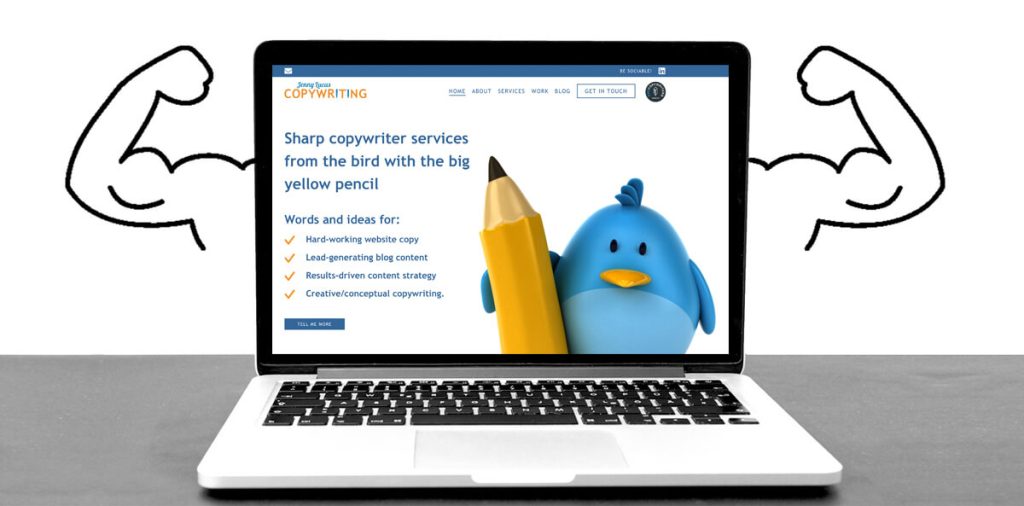“A new website isn’t just arm candy…”
This was the opening line of a LinkedIn post by the lovely, Jo Randall — and it gave me the inspiration for this article.
Jo designs beautiful, results-focused, Squarespace websites for savvy female service-providers. You can check out her website, here.
Why do you want this website?
This is a question I ask potential clients who are getting their first website. I want to understand what’s driven them to get a website and what they imagine it will do for them. Some answers are revealing and give me lots of ideas.
But some answers are more like, because it’s the done thing, because every other business has one or because we want an online presence. These answers aren’t wrong, but they tell me these people don’t truly understand the potential of a new website or what it could do for their business.
How’s your current website working for you?
This is a question I ask potential clients who already have websites. I want to understand how their website is benefitting their business and what it’s doing for them.
Some people have to ask me what I mean by that. They then tell me their website isn’t doing any of the things it should be doing — and, in some cases, it never has.
A website can do wonders for your brand
A well-put-together website — with beautiful, functional design and compelling, optimised words — can make a huge difference for your brand. And you should understand its potential.
This article is for you if:
- You’re getting a website purely because you think you should have one
- Your current website hasn’t made any difference for your business
- You’re curious about the benefits of having a business website.
The benefits of having a business website
A strong website should be doing a lot of the heavy lifting in your business, so you don’t have to work so hard.
The elements of a strong website include:
- Good design and technical SEO
- Useful features, like automated bookings and payments
- A well-managed blog that genuinely helps your audience
- SEO-optimised, persuasive copy that attracts and converts.
And now I’ll show you how they work to benefit your business.


Give your brand a 24/7 online presence
It used to be that if you needed a service, the first thing you’d do is open up the Yellow Pages. If you needed a product, you’d go to the bricks and mortar shop where you could buy it.
Nowadays, the first thing most people do, in either case, is open up Google.
A website makes your brand available 24/7. You could be selling your products to customers all over the world. Or, at 3am, showing Mike from Reading your solution to the problem that’s keeping him awake. You’ve got this, Mike.
Attract more customers
Targeted SEO copywriting will make your website more visible on Google, where your ideal customers can find it.


SEO copywriting involves priming your website with the key words and phrases your target audience is using to find you online. Using the right words and phrases helps Google to understand what your website is about and match it to its users’ search queries.
Making your website more visible for the right keywords will attract your target audience. And when they reach your website, you’ll have the opportunity to sell to them and convert them into paying customers. Kerr-ching!
Reach more of your target market
Your main website should be targeted towards the people who are ready, or almost ready, to buy. But there are whole other audiences you could be targeting with SEO-optimised blog posts.
These people have questions and you can draw them to your website by giving them the answers on your blog.


Let’s have a look at some examples of who else you could be targeting.
People who’ve only just realised they have a problem
These people know they have a problem and don’t yet know what the solution is. Your blog should help them research their problem by giving them the answers and information they need.
People who are looking for solutions
When people have researched the problem and understand what they need to fix it, they’ll be looking for solutions. Your blog should introduce them to their options and help them choose the best one for them.
People who’ve already bought from you
Yes, your existing customers need blog content, too. For example, they might need help, they might be looking for inspiration or they might want buy more in the way of add-ons and upgrades. Your blog should be supporting your business here, with tutorials, troubleshooting, ideas guides and shopping suggestions.
Build your audience’s trust
In the old, pre-internet days, we’d blindly pick a business from the Yellow Pages, without knowing anything about it. And businesses would often choose names beginning with A, because it meant they’d appear near the top of the alphabetical list. Yep, AAA Plumbing and Heating probably didn’t stand for Adam, Angela and Alex.
Thankfully, things have changed now. The internet has forced businesses to be more transparent — because, these days, people need to trust you if they’re going to buy from you.


A beautifully designed and functional website gives you an excellent opportunity to build customer trust, by showing them all the signs that you’re a genuine and reputable business.
For example, you can share:
- Your portfolio/work samples
- Positive reviews and testimonials
- Expertise in the form of blog posts
- Links to your social media accounts
- Customer success stories and case studies.
Get more pre-qualified enquiries
Your website gives your target audience the chance to engage with your brand easily and at their convenience.
It should tell them everything they need to know about your products, services, pricing, process and values. This means when they contact you, it will be a more informed decision and they’ll be more ready to commit.
Save time and spend it more wisely
There are all kinds of things a website can do for your business that will save you time in admin, phone calls and email conversations. And when you’re not having to do those things, you’ll have more time for the things that create value for your business.


Let’s look at some examples.
Answer your audience’s questions
Your website copy should aim to anticipate and answer any question your audience might have before they buy from, or contact, you. This means you won’t have to spend so much time answering these questions yourself.
Use your blog as a helpful resource
If people are always contacting you, needing the same information, this is where your blog comes in. Giving this information in blog posts creates a convenient, 24-hour resource for your visitors, so they always have somewhere to go when they need help or advice.
Automate your admin
You know those tedious, time-consuming admin tasks you hate? Your website can take some of them off your hands.
For example, it can help your visitors by:
- Sending email confirmations and invoices
- Arranging bookings and appointments
- Subscribing them to your list/service
- Handling their subscription renewals
- Taking their orders and payments
- Collecting feedback and reviews.
Embrace online marketing
Having a website means you can take full advantage of online marketing channels, like email and social media. These platforms allow you to build an engaged audience, share your content and direct any interested parties to your website for the full brand experience.
Online marketing can be cost-effective compared to more traditional methods. If you have ideas and a smartphone, you can produce and upload content relatively easily. It’s quick, too, so you can post about the issues of the day and jump on new and emerging trends. All while broadening your reach and driving traffic to your website.
Sell more products
With an automated e-commerce system, your website will allow you to sell around the world and around the clock. So you can literally be making money while you sleep.


For the best results, you need a well-organised website with clear navigation that makes it easy for visitors to find what they’re looking for. And full, clear product descriptions that give them complete confidence to place an order.
Get more subscriptions
This can apply whether you have a paid subscription-based product, such as SaaS (Software as a Service) or a free email marketing list. With the right features, your website can handle the sign-ups, payments and renewals. Leaving you to focus on growing your business by developing new products and content.
Get more enquiries
If you offer a service, a website will help you attract potential new clients. Targeted SEO will help increase the number of visitors you’re getting and good web copy will help improve the quality of those enquiries.
Get valuable customer insights
You can collect all sorts of data from your website to see how people are using it and what they’re interested in.
For example:
- How many visitors your website has had
- Where in the world your visitors are coming from
- How visitors are interacting with your website interface
- Which landing pages they arrived on — which content is popular
- How they came to your site — e.g. Google, socials, direct links
- How long they’re staying on each page — is it long enough?
- Where they go next — is it where you want them to go?
This information can be incredibly helpful if you’re planning improvements to the site or deciding what your future content should be.
Generate more leads
Your website can help you generate more leads for your business by collecting customer data.
For example, you can pick up leads when you:
- Offer free demos and trials
- Subscribe visitors to your email list
- Create shareable content that increases reach
- Put out lead magnets and send follow-up emails
- Create premium, gated content that’s only accessible with a login.
Grow your business
Your website should be your most diligent employee, working 24/7 to bring you all these amazing benefits. And freeing up your time to focus on growth.


With the time you’re saving and the revenue you’re generating, you’ll have more to invest in new products, services and offers. Expanding your offering to help more people and generate more new business.
5 Tips for a cracking website
- Hire the best web designer and SEO copywriter you can afford — and listen to their advice
- Give your copywriter all the information they need to write clear and effective copy
- Tell your designer about the features you need now and ones you might want in future
- Think carefully about the way your content is organised and how users will navigate it
- Invest in a proper content strategy that will genuinely help your target audiences.
Need a top-notch SEO copywriter?
That could be me.
I’m Jenny Lucas, a freelance SEO copywriter and content writer based in Leicester, UK.
I’ve been writing top-notch SEO web copy for the last 15+ years and I also specialise in content strategy.
In short, I have everything you need to make your new/next website a success that will help you attract your ideal customers, educate them, inspire them and sell to them.
You can find out more about me and the work I do:


You might also like…






